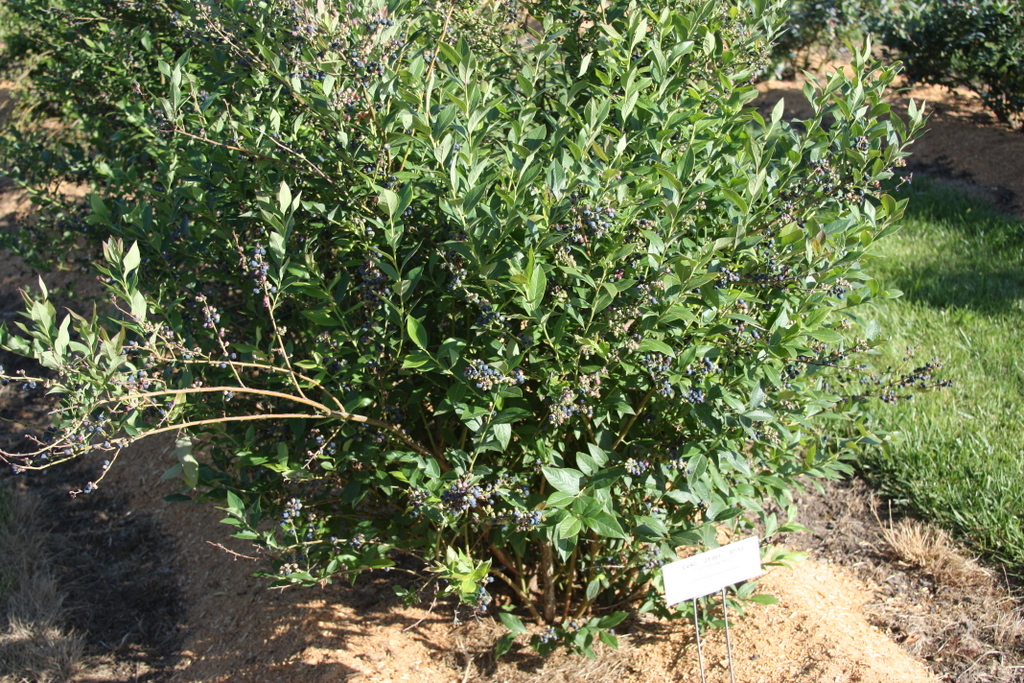Fruits and Nuts
Blueberry ‘Perpetua’ and ‘Echo’ – Repeat Flowering
REFLOWERING ORNAMENTAL BLUEBERRIES FOR NORTHERN CLIMATES, A NEW MARKET CLASS MADE POSSIBLE BY PLANT GERMPLASM CONSERVATION
Ryan M. King and Nahla V. Bassil
USDA-ARS National Clonal Germplasm Repository, 33447 Peoria Rd, Corvallis, Oregon 97333.
Corresponding author: ryan.m.king@usda.gov
OUTLINE
1. SUMMARY

The USDA-ARS blueberry breeding project in Corvallis, Oregon in cooperation with Oregon State University identified the repeat flowering trait in open-pollinated seedlings from a Vaccinium accession (PI 296412) growing in the USDA National Clonal Germplasm Repository (NCGR) field collection in Corvallis. PI 296412 was collected from the wild from Mount Pisgah in Monmouth, Maine in 1963; it is thought to be a hybrid of V. corymbosum and V. angustifolium, as it appears to have characteristics unique to each and these species both grow in this region and naturally hybridize. The project released ‘Perpetua’ (PI 674714) in 2015, which was an open-pollinated seedling of PI 296412.
Seedlings that had repeat flowering and other valuable traits were selected and advanced in the breeding project. The breeding project also released ‘Echo’ (PI 682654) in 2019, which is the result of a cross between ‘Perpetua’ and ORUS 55-1 (PI 296397). ‘Echo’s paternal parent, ORUS 55-1, is a seedling of another wild-collected Maine accession in the NCGR field collection, crossed to ORUS 7-1. Both cultivars are repeat flowering and suitable for ornamental and home garden uses, but are not suitable for production markets due to soft fruits with wet picking scars. The breeding project is working to develop improved remontant (repeat flowering) cultivars with better flavor that are more suitable for the fresh and processing production markets.
The goal was to release cultivars with the repeat-flowering, double-cropping trait that are suitable for production in Northern climates.
Download a printable fact sheet by clicking the image below.
2. PROBLEMS ADDRESSED

Most Northern-adapted blueberries have one flush of flowers and fruit and harvest seasons that are limited to 3 to 5 weeks.
3. SOLUTIONS DEVELOPED

‘Perpetua’ and ‘Echo’ have at least two flushes of flowers and fruit. In the Pacific Northwest, these cultivars have one flush of flowers in late spring and fruit in mid-summer, and another flush of flowers and fruit in the fall until a hard frost stops their development. The reflowering trait allows for a longer, more diversified season and multiple flushes of fresh fruit on a long-lived perennial crop.
Collaborators involved in developing solution:
- Chad E. Finn, Theodore A. Mackey, and Robert R. Martin, USDA-ARS Horticultural Crops Research Unit, Corvallis, Oregon, USA
- Bernadine C. Strik and Patrick A. Jones, Oregon State University, Corvallis, Oregon, USA
- Nahla V. Bassil and Kim E. Hummer, USDA-ARS NCGR, Corvallis, Oregon, USA
4. GERMPLASM

The germplasm that contributed to developing reflowering blueberries included genebank accessions, breeding lines, and crop wild relatives.
‘Perpetua’ (PI 674714) is an open-pollinated seedling of CVAC 45 (PI 296412). ‘Echo’ (PI 682654) is the result of a cross between ‘Perpetua’ (PI 674714) and ORUS 55-1 (PI 296397). The USDA National Plant Germplasm System conserves these plant genetic resources; more information about them can be found online at GRIN-Global.
5. ADDITIONAL RESOURCES
Finn CE, Strik BC, Mackey TA, Hummer KE, Martin RR. 2015. ‘Perpetua’ Ornamental Reflowering Blueberry. HortScience 50:1828-1829. https://doi.org/10.21273/HORTSCI.50.12.1828
Finn CE, Strik BC, Mackey TA, Jones PA, Bassil NV, Martin RR. 2019. ‘Echo’ Ornamental Reflowering Blueberry. HortScience 54:368-370. https://doi.org/10.21273/HORTSCI13646-18
Perpetua and Echo were developed by the USDA Agricultural Research Service (ARS). More information on ARS technologies, visit the website for the Office of Technology Transfer (OTT).
6. CHAPTER INFORMATION
Citation: King R, Bassil N. 2023. Blueberry ‘Perpetua’ and ‘Echo’ – Repeat Flowering. In: Volk GM, Chen K, Byrne P (Eds.) Plant Genetic Resources: Success Stories. Fort Collins, Colorado: Colorado State University. Date accessed. Available from https://colostate.pressbooks.pub/pgrsuccessstories/chapter/blueberry-perpetua-and-echo-repeat-flowering/
Content originally submitted: December 29, 2022
Date of publication: July 2023
USDA is an equal opportunity provider, employer, and lender. Mention of trade names or commercial products in this article is solely for the purpose of providing specific information and does not imply recommendation or endorsement by the U.S. Department of Agriculture.


